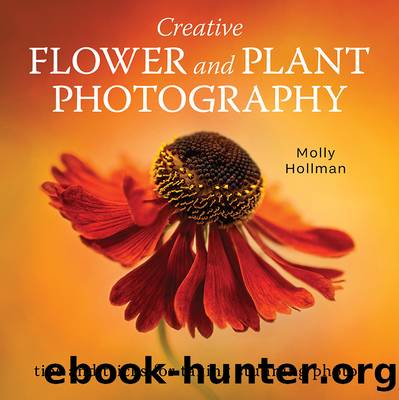Creative Flower and Plant Photography by Hollman Molly;

Author:Hollman, Molly;
Language: eng
Format: epub
Publisher: The Crowood Press
The finished photo. I used a long lens with an aperture of f/5.6 on this occasion as I wanted a substantial section of the flower to be in focus, even though these Iris reticulata flowers are very small (only just over an inch high).
This ladybird on miscanthus grass image was taken with a generic extension tube of 10mm on a 55mm lens. I love the way that both the grass heads and stalk are blurred out â it enhances the composition of the photo.
As the ladybird is only a small point of focus in the photo, it works; however, had I wanted the ladybird to be larger in the frame I would have had to increase my aperture value; with my macro lens (105mm) I usually photograph ladybirds at about f/9â11.
When you find a good flower or plant, try to take lots of shots from as many different angles as you can: above; underneath; from the side and so on. Make sure you locate the point of focus really carefully on the subject of your image as a starting point.
I discovered some thick-legged beetles and Spanish oil beetles in amongst some yellow marguerite daisies last year and took lots of shots from different angles.
At home later I experimented with cropping my images for more interesting compositions; it helps to have plenty to choose from. Whilst all of these above examples work as compositions, you may prefer one to the others and this is always subjective and depends on experience, taste and so on. Specialist macro photographers would probably say that none of them are technically macro, as they are not close-up enough, but if you are enjoying the photography it doesnât matter; even at competition level there are usually categories to cater for all varieties of close-up and macro. Insects are a very popular macro subject and Iâll talk more about photographing them in the chapter on wildlife in the garden.
You donât always have to focus on the centre of the flower; youâll sometimes find that the curve of a leaf or petal can provide an equally beautiful point of interest. When youâve taken your first photo, move around slightly and look at whatâs happening behind the flower; look for backgrounds that will either complement or contrast with your subject.
If I have small flowers growing in my own garden that I want to photograph close up Iâll often take one of my photo backdrops outside and clip it to a bush or tree behind the subject. Iâll clip any distracting foliage out of the way so that the flower I want is in focus and clean.
Sometimes this can look unnatural, but experiment with different backgrounds â perhaps thereâs a group of flowers at a distance that will be as effective a background â and youâll find something you like. For a natural look you canât beat shooting macro outside, and whilst you can âfakeâ it digitally with an indoor set-up, itâs usually never quite the same. I love photographing with my indoor set-up, but for me itâs never quite as fun as being outside in nature.
Download
This site does not store any files on its server. We only index and link to content provided by other sites. Please contact the content providers to delete copyright contents if any and email us, we'll remove relevant links or contents immediately.
| Color | Darkroom & Processing |
| Digital Editing | Equipment |
| Flash Photography | Handbooks & Manuals |
| Lighting | Reference |
Shoot Sexy by Ryan Armbrust(17565)
Portrait Mastery in Black & White: Learn the Signature Style of a Legendary Photographer by Tim Kelly(16878)
Adobe Camera Raw For Digital Photographers Only by Rob Sheppard(16806)
Photographically Speaking: A Deeper Look at Creating Stronger Images (Eva Spring's Library) by David duChemin(16507)
Bombshells: Glamour Girls of a Lifetime by Sullivan Steve(13706)
Art Nude Photography Explained: How to Photograph and Understand Great Art Nude Images by Simon Walden(12859)
Perfect Rhythm by Jae(5083)
Pillow Thoughts by Courtney Peppernell(4039)
The Book of Joy by Dalai Lama(3713)
Good by S. Walden(3361)
The Pixar Touch by David A. Price(3226)
A Dictionary of Sociology by Unknown(2865)
Fantastic Beasts: The Crimes of Grindelwald by J. K. Rowling(2855)
Stacked Decks by The Rotenberg Collection(2701)
Humans of New York by Brandon Stanton(2696)
Read This If You Want to Take Great Photographs by Carroll Henry(2610)
On Photography by Susan Sontag(2495)
Photographic Guide to the Birds of Indonesia by Strange Morten;(2413)
Insomniac City by Bill Hayes(2406)
